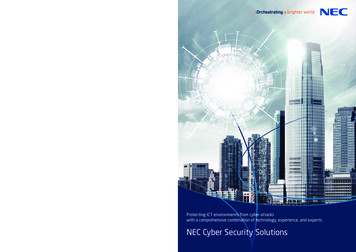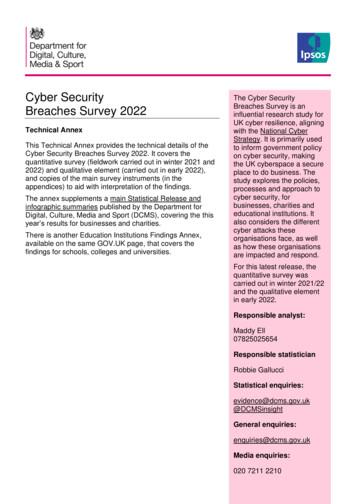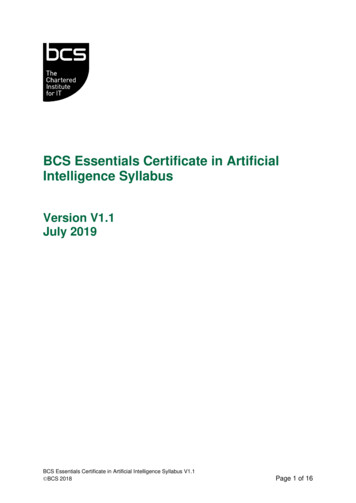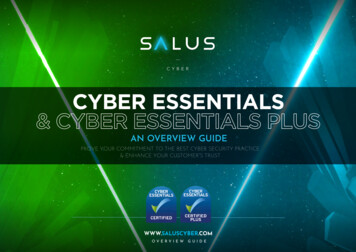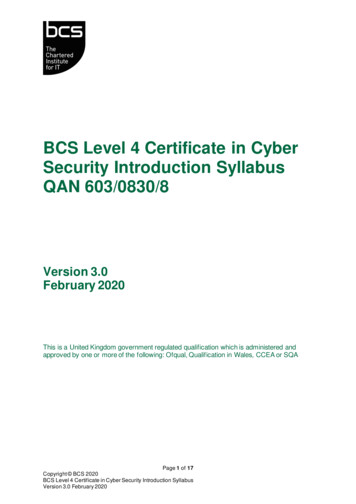
Transcription
BCS Level 4 Certificate in CyberSecurity Introduction SyllabusQAN 603/0830/8Version 3.0February 2020This is a United Kingdom government regulated qualification which is administered andapproved by one or more of the following: Ofqual, Qualification in Wales, CCEA or SQAPage 1 of 17Copyright BCS 2020BCS Level 4 Certificate in Cyber Security Introduction SyllabusVersion 3.0 February 2020
BCS Level 4 Certificate in Cyber SecurityIntroduction SyllabusContentsIntroduction .4Objectives .4Course Format and Duration .4Eligibility for the Examination.5Duration and Format of the Examination.5Additional Time for Apprentices Requiring Reasonable Adjustments Due to a Disability.5Additional Time for Apprentices Whose Language Is Not the Language of the Exam .5Guidelines for Accredited Training Organisations 6Syllabus .7Levels of Knowledge / SFIA Levels .16Question Weighting.16Format of Examination.17Trainer Criteria .17Classroom Size .17Recommended Reading List .17Page 2 of 17Copyright BCS 2020BCS Level 4 Certificate in Cyber Security Introduction SyllabusVersion 3.0 February 2020
Change HistoryAny changes made to the syllabus shall be clearly documented with a change history log.This shall include the latest version number, date of the amendment and changes made.The purpose is to identify quickly what changes have been made.Version NumberVersion 1.0 Nov2016Version 1.1 Nov2016Version 1.2 Nov2016Version 2.0September 2019Version 3.0February 2020Changes MadeSyllabus CreatedAmended terminology for HarbourAdded mandatory Ofqual textUpdate to Question Weighting.Removed “including, but not limited to” from all learning outcomes.Full syllabus review.Page 3 of 17Copyright BCS 2020BCS Level 4 Certificate in Cyber Security Introduction SyllabusVersion 3.0 February 2020
IntroductionThis certificate is the core module that is applicable to both pathways of the Level 4 CyberSecurity Technologist Apprenticeship. This is a general introduction to cyber security and isthe core element of the apprenticeship. It covers the essential knowledge foundation formost cyber security roles.ObjectivesApprentices should be able to demonstrate an understanding of the foundations of cybersecurity. Key areas are:1.2.3.4.Explain why cyber security matters.Explain basic security theory.Describe and explain security assurance.Apply basic security concepts to develop security requirements (to help build a securitycase).5. Describe security concepts applied to ICT (‘cyber’) infrastructure.6. Describe and explain attack techniques.7. Describe cyber defence.8. Describe and explain legislation, standards, regulations and ethical standards relevantto cyber security.9. Understands how to keep up with the threat landscape.10. Describe future trends.Evidence of lessons learnt in these key areas should be collected and reflected upon whenthe Apprentice is compiling the Summative Portfolio as the apprentice could identify how thetask might be done better/differently with knowledge subsequently gained.Target AudienceThe certificate is relevant to anyone requiring an understanding of the core principles andfoundations of a Cyber Security Technologist.Course Format and DurationApprentices can study for this certificate by attending a training course provided by a BCSaccredited Training Provider. The estimated total qualification time for this certificate is 199hours.Page 4 of 17Copyright BCS 2020BCS Level 4 Certificate in Cyber Security Introduction SyllabusVersion 3.0 February 2020
Eligibility for the ExaminationThere are no specific pre-requisites for entry to the examination; however, apprenticesshould possess the appropriate level of knowledge to fulfil the objective shown above.Individual employers will set the selection criteria, but this is likely to include A’ Levels, arelevant Level 3 apprenticeship, or other relevant qualifications, relevant experience and/oran aptitude test with a focus on functional maths.Duration and Format of the ExaminationThe format for the examination is a one-hour multiple-choice examination consisting of 40questions. The examination is closed book (no materials can be taken into the examinationroom). The pass mark is 26/40 (65%).Additional Time for Apprentices Requiring ReasonableAdjustments Due to a DisabilityApprentices may request additional time if they require reasonable adjustments. Please referto the reasonable adjustments policy for detailed information on how and when to apply.Additional Time for Apprentices Whose Language IsNot the Language of the ExamIf the examination is taken in a language that is not the apprentice’s native/official language,then they are entitled to 25% extra time.If the examination is taken in a language that is not the apprentice’s native/official language,then they are entitled to use their own paper language dictionary (whose purpose istranslation between the examination language and another national language) during theexamination. Electronic versions of dictionaries will not be allowed into the examinationroom.Page 5 of 17Copyright BCS 2020BCS Level 4 Certificate in Cyber Security Introduction SyllabusVersion 3.0 February 2020
Guidelines for Accredited Training OrganisationsEach major subject heading in this syllabus is assigned an allocated time. The purpose ofthis is two-fold: firstly, to give both guidance on the relative proportion of time to be allocatedto each section of an accredited course and an approximate minimum time for the teachingof each section; secondly, to guide the proportion of questions in the exam. AccreditedTraining Organisations may spend more time than is indicated and apprentices may spendmore time again in reading and research. Courses do not have to follow the same order asthe syllabus. Courses may be run as a single module or broken down into two or threesmaller modules.This syllabus is structured into sections relating to major subject headings and numberedwith a single digit section number. Each section is allocated a minimum contact time forpresentation. Apprentices should be encouraged to consider their Summative Portfoliothroughout the modules.Page 6 of 17Copyright BCS 2020BCS Level 4 Certificate in Cyber Security Introduction SyllabusVersion 3.0 February 2020
SyllabusFor each top-level area of the syllabus, a percentage and K level is identified. Thepercentage is the exam coverage of that area, and the K level identifies the maximum levelof knowledge that may be examined for that area.1. Why Cyber Security Matters (12.5%, K2)In this key topic, the apprentice will describe and explain why information and cyber securityare important to businesses and to society. Outcomes should include an ability to:1.1Describe what information assets and information processing systems are.1.2Explain why information assets and related systems need to be protected.1.3Describe the impact, negative or positive, a security incident could have on anorganisation. financial; operational; reputational; legal; regulatory.1.4Discuss how information and cyber security impacts different types of organisations. public; private; CNI; different industries; different geographical locations; large enterprise; small business; charity/non-profit.1.5Describe how information and cyber security can affect society: citizens; not for profit groups; public services.Page 7 of 17Copyright BCS 2020BCS Level 4 Certificate in Cyber Security Introduction SyllabusVersion 3.0 February 2020
2. Basic Security Theory (20%, K2)In this key topic, the apprentice will describe and explain the terminology and basic conceptsof cyber security. Outcomes should include an ability to:2.1Describe confidentiality, integrity, availability, identity, authentication andnonrepudiation.2.2Explain how threats and vulnerabilities create risk.2.3Explain how likelihood and impact are used to determine risk and how this is recorded. risk register.2.4Describe how defending information assets and related systems is asymmetricbecause every risk needs to be treated whilst attackers only need to exploit one.2.5Describe sources of threats and their capability, motivations and opportunity. individuals; groups (criminal and political); nation states; insiders (deliberate or accidental).2.6Describe how environmental hazards and inadequate system design and maintenancecreate risks.2.7Explain how the organisation's culture and security objectives govern the types ofcontrols selected.2.8Explain how risk appetite is determined and what risk treatment options are available . accept; reduce; avoid; transfer or share.Page 8 of 17Copyright BCS 2020BCS Level 4 Certificate in Cyber Security Introduction SyllabusVersion 3.0 February 2020
3. Security Assurance (12.5%, K2)In this key topic, the apprentice will explain security assurance concepts and practices.Outcomes should include an ability to:3.1Explain what 'trusted' (e.g. proven through the use of PKI certificates) and 'trustworthy'(e.g. implied by the use of secure development methodologies) mean when applied toinformation security assurance.3.2Explain what is meant by the following approaches to assurance and describe whenthey can be used: intrinsic assurance (confidence in the process used by the supplier duringdevelopment by following a recognised standard); extrinsic assurance (independent of the development environment using externalevaluation); design & implementation (designed and implemented to a recognised standard); operational policy & process (operated and maintained to a recognised standard).3.3Explain that penetration testing is a form of assurance ideally carried out byprofessionals using industry recognised ethical methods to test the technical andorganisational controls in place. pen test; red team exercise; bug/bounty hunter.3.4Describe the benefits and limitations of extrinsic assurance methods. security testing (an automated review against known vulnerabilities only); supply chain testing (point in time audit of suppliers' technical and organisationalcontrols against a recognised standard or their compliance with legal and regulatoryrequirements); Common Criteria (a review of the organisations requirements against a standardspecific to the technology).3.5Describe ways an organisation can use intrinsic assurance: what certifications does the supplier hold e.g. ISO27001, ISO9001; what standards have a supplier's products been certified against e.g. FIPS.Page 9 of 17Copyright BCS 2020BCS Level 4 Certificate in Cyber Security Introduction SyllabusVersion 3.0 February 2020
4. Applying basic security concepts (5%, K3)In this key topic, the apprentice understand how to apply basic security concepts. Outcomesshould include an ability to:4.1Describe what security objectives and security requirements are and what they shouldinclude: Functional requirements; Non-functional requirements; Relative priority (MoSCoW); KPIs; Responsibility.4.2Justify how security objectives are applied to information assets and infrastructureassets in different business scenarios depending on the value of the asset and the partthe asset plays in the scenario. Migrating from an on-premise solution to a cloud service; Developing a new product that uses customer data; Outsourcing key business process.5. Security concepts applied to ICT (‘cyber’) infrastructure (7.5%, K1)In this key topic, the apprentice will describe security concepts applied to ICT infrastructure.Outcomes should include an ability to:5.1Describe common vulnerabilities in computer networks and systems: non-secure coding; inadequate traffic filtering; missing patches and updates; inappropriate configuration; insecure protocols; lack of malware protection; inadequate access controls (identification, authentication, authorisation, ACLs) inappropriate design and architecture; lack of consideration of environmental factors; inadequate physical security controls; interoperabilityPage 10 of 17Copyright BCS 2020BCS Level 4 Certificate in Cyber Security Introduction SyllabusVersion 3.0 February 2020
5.2Describe the building blocks of computers, networks and the internet: input devices; output devices; routers; switches; hubs; wireless access points and controllers; clients and servers local and networked storage; network transmission media; industrial control systems; data centres.5.3Describe typical architectures of computers, networks and the internet. wireless and wired; operating systems; fat and thin clients; physical and virtual; hub and spoke; mesh network; redundant hardware and transmission paths.6. Attack Techniques and Common Sources of Threat (12.5%, K2)In this key topic, the apprentice will describe and explain common sources of threat andattack techniques. Outcomes should include an ability to:6.1Describe the main attack techniques and explain how they work and where they aresuccessful: phishing and its variations; social engineering; malware; network interception; advanced persistent threats; DOS and DDOS; credential theft; physical theft; business email compromise.6.2List insider threats malicious employee; negligent employee; inadequately trained employee; unmanaged 3rd party staff.Page 11 of 17Copyright BCS 2020BCS Level 4 Certificate in Cyber Security Introduction SyllabusVersion 3.0 February 2020
6.3Describe the factors that contribute to a negative or positive cyber securityenvironment: management direction through policy; communication; training and awareness; incident reporting; roles and responsibilities; whistleblowing.6.4Explain how a threat is the result of an attack technique combined with motive andopportunity. Motive:o criminal;o political;o reputational. Opportunity:o M&A;o fluctuations in currency or asset value;o changes to technology;o change in personnel;o changes in political landscape;o new vulnerabilities in products disclosed.6.5Describe how environmental hazards such as fire and flood can result in the sameimpact as an attack.Page 12 of 17Copyright BCS 2020BCS Level 4 Certificate in Cyber Security Introduction SyllabusVersion 3.0 February 2020
7. Cyber Defence (5%, K2)In this key topic, the apprentice will describe cyber defence techniques. Outcomes shouldinclude an ability to:7.1List the main defensive techniques, classify them as deter, protect, detect or react anddescribe how they can be used together to create defence in depth. perimeter controls; traffic filtering; least privilege; authentication and authorisation; anti-malware; application whitelisting; proactive monitoring; secure configuration; intrusion detection and prevention; file integrity monitoring; data loss prevention; patching and updating; change control; encrypted connections.7.2Describe the benefits of using the MITRE ATT&CK model. initial access; execution; persistence; privileged escalation; defence evasion; credential access; discovery; lateral movement; collection; exfiltration; command and control.Page 13 of 17Copyright BCS 2020BCS Level 4 Certificate in Cyber Security Introduction SyllabusVersion 3.0 February 2020
8. Legal, Standards, Regulations and Ethical Standards Relevant to Cyber Security(17.5%, K2)In this key topic, the apprentice will describe and explain legislation, standards, regulationsand ethical standards relevant to cyber security. Outcomes should include an ability to:8.1Describe the cyber security standards and regulations and their consequences for thefollowing sectors: Government (HMG Security Policy Framework, Cyber Essentials); Finance (PCI-DSS, NIST, ISO27001, FCA, PRA, CBEST); Defence (Def Stan 05-138, JSP440, JSP604, NIST) CNI (NISD, Operational Guidelines for Industrial Automated Control Systems(IACS)).8.2Explain the role of laws and regulations on cyber security with reference to: criminal law (e.g. Computer Misuse Act, Data Protection Act); contract law (service delivery management and meeting SLAs); industry specific regulations (e.g. finance, health).8.3Explain the benefits, costs and motives for uptake of security standards byorganisations including: PCI-DSS; ISO27001; Cyber Essentials.8.4Describe the key features of relevant UK law that affect cyber security for individualsand organisations including; Computer Misuse Act; Data Protection Act; Human Rights Act; Copywrite, Designs and Patents Act.8.5Describe the key features of relevant international laws and regulations and theirimplications for cross border movement of data and products including: Digital Millennium Act; ITAR; EU-US Privacy Shield (replaced Safe Harbour); General Data Protection Regulation; Patriot Act.8.6Describe the legal responsibilities of systems users and how the following are used tocommunicate them: acceptable use policies; logon banners; training and awareness programmes.Page 14 of 17Copyright BCS 2020BCS Level 4 Certificate in Cyber Security Introduction SyllabusVersion 3.0 February 2020
8.7Describe the ethics and codes of conduct for cyber security professionals withreference to following professional bodies: BCS; CIISec (formally IISP); ISACA; (ISC)2.9. Keeping Up with the Threat Landscape (2.5%, K2)In this key topic, the apprentice will describe how to keep up with the threat landscape.Outcomes should include an ability to:9.1Describe horizon scanning with reference to the following source types: market trend reports (vendor reports, Gartner, ISF); academic research papers; professional journals (e.g. IEEE, IET, Oxford Academic, BCS); hacker conferences (e.g. BlackHat, BSides); government sponsored online sources (e.g. CiSP, ENISA).9.2Describe diversity when using horizon scanning with reference to: Delphi method; trend impact analysis.10. Trends in Cyber Security (5%, K2)In this key topic, the apprentice will describe trends on cyber security and explain the valueof analysing future trends. Outcomes should include an ability to:10.1 Describe trends in cyber security and their significance. IoT security; AI; quantum computing.10.2 Explain the value and risk of analysing future trends. future proofing investment in technology; including future security requirements when planning changes and upgrades; under investing in categories of controls; training cyber security professionals in the right skills.Page 15 of 17Copyright BCS 2020BCS Level 4 Certificate in Cyber Security Introduction SyllabusVersion 3.0 February 2020
Levels of Knowledge / SFIA LevelsThis course will provide apprentices with the levels of difficulty / knowledge skill highlightedwithin the following table, enabling them to develop the skills to operate at the levels ofresponsibility indicated. The levels of knowledge and SFIA levels are explained in on thewebsite www.bcs.org/levels. The levels of knowledge above will enable apprentices todevelop the following levels of skill to be able to operate at the following levels ofresponsibility (as defined within the SFIA framework) within their workplace:LevelK7K6K5K4K3K2K1Levels of ememberLevels of Skill and Responsibility (SFIA)Set strategy, inspire and mobiliseInitiate and influenceEnsure and adviseEnableApplyAssistFollowQuestion WeightingSyllabus Area1. Why Cyber Security Matters2. Basic Security Theory3. Security Assurance.4. Applying basic security concepts5. Security concepts applied to ICT(‘cyber’) infrastructure6. Attack Techniques and CommonSources of Threat7. Cyber Defence.8. Legal, standards, regulations andethical standards relevant to cybersecurity9. Keeping up with the threat landscape10. Trends in Cyber SecurityTotalPage 16 of 17Copyright BCS 2020BCS Level 4 Certificate in Cyber Security Introduction SyllabusVersion 3.0 February 2020Target number of questions585235271240 Questions
Format of ExaminationType40 Question Multiple Choice.Duration1 Hour. An additional 15 minutes will be allowed for apprentices sittingthe examination in a language that is not their native /mother tongue.Pre-requisitesAccredited training is strongly recommended but is not a pre-requisite.SupervisedYes.Open BookNo.Pass Mark26/40 (65%).CalculatorsCalculators cannot be used during this examination.Total QualificationTime (TQT)199 Hours.DeliveryOnline.Trainer Criteria Criteria Have 10 days’ training experience or have a Train the TrainerqualificationHave a minimum of 3 years’ practical experience in the subjectareaClassroom SizeTrainer to apprenticeratio1:16Recommended Reading ListTitle:Author:Publisher:Publication Date:ISBN-13:Information Security Management PrinciplesTaylor, A. et al.BCS, The Chartered Institute for IT; 3rd edition31 Jan n Date:ISBN-13:Cyber Security A practitioner's guideSutton, D.BCS, The Chartered Institute for IT10 Jul 20179781780173405Page 17 of 17Copyright BCS 2020BCS Level 4 Certificate in Cyber Security Introduction SyllabusVersion 3.0 February 2020
This is a general introduction to cyber security and is the core element of the apprenticeship. It covers the essential knowledge foundation for most cyber security roles. Objectives Apprentices should be able to demonstrate an understanding of the foundations of cyber security. Key areas are: 1. Explain why cyber security matters. 2.





